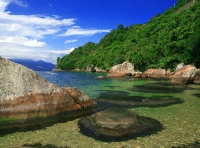
This peninsula and group of 365 islands (one for each day of the year) is a holiday playground that contains 2,000 beautiful beaches and a natural wonderland of mountains, forests, waterfalls, lakes, and secret coves. Visitors can take trips by schooner, yacht, or motor launch to explore the delights of the area, particularly the main island, Ilha Grande. Fishing and scuba diving are the favoured activities for tourists amongst the various water sports, while on land there are hundreds of walking trails giving access to some of the less frequented beaches like Canto, Abraaozinho, Morcego, and Grande das Palmas. The beaches of Aventureiro and Lopes Mendes are also popular with surfers.The islands can easily be reached from Rio by road in just over three hours, or accessed by bus with daily departures every hour from the Novo Rio Bus Station.
Website : www.angra-dos-reis.com
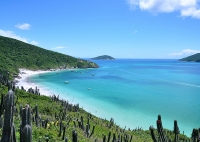
Once the preserve of pirates and slave traders, the peninsula of Buzios, 109 miles (176km) northeast of Rio de Janeiro, is today the haunt of the rich and famous who flock to the city to enjoy the 24 beaches in the vicinity. The peninsula was popularised by legendary movie star Brigitte Bardot in the 1960s, whose statue still graces the main street of Buzios, the Rua des Pedras. The peninsula is a sophisticated beach resort with a very active nightlife and fine restaurants. The west coast beaches offer calm, clear waters ideal for swimming, while the east coast beaches face the open sea and are a little wilder, drawing surfers and water sports enthusiasts to its choppy waters. Among the most popular beaches are Azeda Beach, Joao Fernandinho Beach (with several bars and known for its good seafood), Ferradura Beach, and Geriba beach, which is popular for surfing.Buzios can be reached by road from Rio via the Rio-Niteroi toll bridge, or by bus from the Novo Rio Bus Station.
Website : www.buziosonline.com.br
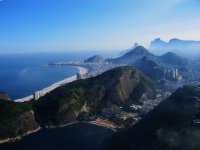
This famous Rio beach neighbourhood was just a small fishing village until a new highway built in the early 1900s brought crowds of visitors to these golden shores. The Copacabana Palace Hotel first opened its doors in 1923, and since then the area mushroomed with Neoclassical and Art Nouveau skyscrapers, penthouses, and apartments. Visitors still flock, as they have always done, to the glamorous Palace Hotel, which is the place to be seen, especially to have tea or a meal at the famed Cipriani restaurant.The beach itself white sand and calm water and is festooned with kiosks. It is a popular spot for beach sports like soccer and volleyball, and a good place to sunbathe. Copacabana beach is particularly popular on New Year's Day. According to tradition, visitors dress in white and congregate here to celebrate in droves, with more than 2 million people crowding the beach.
The distinctive statue of Christ the Redeemer, arms spread to welcome the world, is the symbol of Rio de Janeiro and one of the seven New Wonders of the Modern World. It rests on top of Rio de Janeiro's Corcovado Mountain, 2,330 feet (710m) above the beaches below, and is accessed via a miniature train that runs from the Cosme Vehlo District through the Atlantic rainforest to the foot of the statue. The train ride offers stunning vistas of Rio, and the view from the summit is breathtaking.Spread out beneath the statue is the Tijuca Forest, resplendent with attractions to enchant visitors beneath the cooling canopy among natural pools and waterfalls. There is, for example, the Mayrink chapel, which features murals painted by Candido Portinari, one of Brazil's most well-known modern artists, and the Museu do Acude, housing colonial furniture and a collection of china from the East India Company.
Address : Corcovado Railroad Station. Rua Cosme Velho 513, Cosme Velho
Website : www.corcovado.com.br
Telephone : +55 21 2558 1329
Opening times : Open daily, from 8am to 7pm. Train departs every 30 minutes.
Admission : BRL 75 (adults - weekends and high season), BRL 62 (adults - low season), BRL 49 (children) for a round-trip and entry to the Christ the Redeemer Statue.
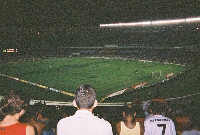
Proudly hosting the opening and closing matches of the 2014 Soccer World Cup and 2016 Olympic Games ceremonies, and still the largest soccer stadium on the continent, Rio's Maracana has seen many records set.The stadium currently hosts local soccer league games, and is the home of the Brazilian soccer team. But with a capacity of more than 78,000, the Maracana is more than able to host international acts visiting Brazil as a performance venue, with Madonna and Sir Paul McCartney among the big names who have played here. Inside the grounds is a Hall of Fame honouring soccer greats such as Pele, Roberto Dinamite, Romário, Valdo, and Bebeto, all of whom have been honoured by having their footprints cast in the sidewalk. A guided tour takes visitors through the hall, where they can enjoy a display of historical photographs and a great panoramic view of the city, among other things.
Address : Av. Pres. Castelo Branco, Portão 3 - Maracanã
Website : www.maracana.com
Opening times : Open daily, from 9am to 5pm
Admission : Basic tour costs BRL 36 (Monday to Thursday), or BRL 40 (Friday to Sunday)
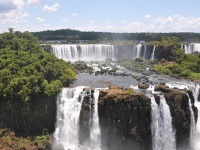
The Rio Iguaçu begins its journey in the coastal mountains of Paraná and Santa Catarina, snaking west for 370 miles (600km) before it widens majestically, plunging and crashing through the jungle in tiered falls at the border with Argentina and Paraguay. The Foz do Iguaçu (Iguaçu Falls) are more than two miles (3km) wide and 262ft (80m) high (almost twice the height of Niagara Falls), and their beauty is unmatched. Their name, fittingly, comes from the Guarani Indian word meaning 'great waters'. The deep flowing waters of the river tumble down 275 falls, the most famous of which is Devil's Throat on the Argentinian border, with a drop of 230ft (70m).As well as taking in the stunning views, visitors can enjoy kayaking and other water sports in the river. The best time of year to visit is August to November, when there is least risk of floodwaters hindering the approach to the boardwalks. The falls are surrounded by the Iguaçu National Park, a huge sub-tropical rainforest covering 135,000 acres that is home to thousands of different species of animals and birds including parrots and hummingbirds.
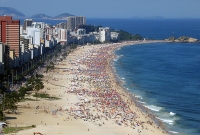
Immortalised in a popular song, 'The girl from Ipanema', this neighbourhood of Rio offers not only a legendary beach, but numerous excellent hotels, a bustling nightlife, sophisticated shopping opportunities, and quality restaurants, all within walking distance of each other. Ipanema, the name, incongruously, means 'bad water', is famous for setting fashion trends, particularly in the line of skimpy swimwear. Fashion followers should look out for the famous bikini boutiques like Salinas, Blue Man, and Bum-Bum. Tourists should make sure to explore the Rua Garcia D'Avila to shop for designer fashion, jewellery, and furniture. The nearby Amsterdam Sauer Museum of Gems makes for an interesting tour around the workshop. There are numerous other streets in and around Ipanema to explore, including the eclectic commercial street Visconde de Piraja, lined with speciality shops, bars, restaurants, and some of Rio's best boutiques. Visit the bohemian fair at General Osorio Square on Sundays for wooden sculptures, handcrafts, exotic musical instruments, and artworks.
Address : Avenida Vieira Souto
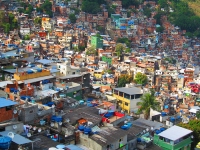
Even though Rio de Janeiro is one of the world's foremost holiday destinations, with great beaches, vibrant night-life, and significant tourist attractions, the hard fact is that it remains a city of gross economic inequality, as typified by its sprawling urban slums (favelas), the largest of which, Rocinha, is home to nearly a quarter of a million people. For tourists looking to get to grips with this social reality, a local named Zezinho runs widely-celebrated tours of Rocinha, the favela in which he grew up.Those worrying that it will be a typical, voyeuristic, seen-from-the-back-of-a-Jeep experience can lay those fears to rest: the great strength of Zezinho's tours is that they are conducted out of love for Rocinha, and a desire to share its culture with foreigners. As Zezinho says, 'It is easy to see poverty or poorly built houses, but what I love about Rocinha is the spirit of the people'. All who take part in his tour of Rocinha agree that it's a valuable, moving and humanising touristic experience. There are also other guides and companies offering good tours of the various favelas. It is important to book in advance.
Address : Túnel Zuzu Angel, west of the Ipanema area
Website : www.favelatour.org
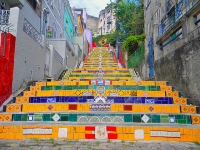
Having had their fill of the beach, tourists seeking the 'real Rio de Janeiro' should make a beeline for one of its most iconic neighbourhoods, Santa Teresa. Located at the top of Santa Teresa Hill, the neighbourhood is famous for its winding, narrow streets, its 19th century architecture, and its amazing array of restaurants, bars, art galleries, and eclectic shops. A popular area for local artists and tourists alike, Santa Teresa is best reached using its historic tram service, which runs up the hill from the centro (departing from Largo da Carioca square). The tram line, the only one of its kind in Rio, runs right through Santa Teresa's picturesque streets, offering magnificent views of the city below. By all accounts, no visit to Rio de Janeiro would be complete without spending at least a few hours in Santa Teresa.
Address : On the top of Santa Teresa Hill, near the centre of Rio de Janeiro
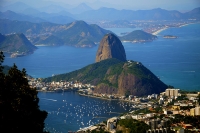
An iconic fixture of the Rio skyline, the Sugarloaf Mountain is known worldwide for its sweeping views of the city below. The summit of the 1,299 foot high (396m) belvedere, named Sugar Loaf because of its resemblance to the loaves of sugar used by the Portuguese colonists, can be reached by a two-stage cable car ride. The first stage takes visitors up 722 feet (220m) to the Morro da Urca, where there is a restaurant, amphitheatre, heliport and spectacular view of the Yacht Club and Botafogo Bay. The second stage ascends to the summit for a panoramic view of the city, and the whole of Copacabana beach. The Sugar Loaf cable car is a major icon of Rio's tourism and a trip up the Sugar Loaf is a must for visitors to the city.
Address : Avenue Pasteur 520, Praia Vermelha
Website : www.bondinho.com.br
Opening times : Open daily, from 8am to 7.50pm
Admission : Cable Car: BRL 76 (adults), BRL 38 (youths aged 6-21), free for children under 6.

Travel Guide powered by Word Travels, copyright © 2023 Globe Media Ltd. By its very nature information in this travel guide is subject to change at short notice and travellers are urged to verify information on which they're relying with the relevant authorities. Neither Globe Media Ltd nor Travel Vogue can accept any responsibility for any loss or inconvenience to any person as a result of information contained above.